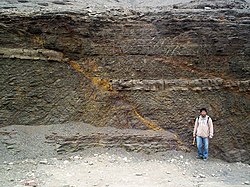| Morro Solar Group | |
|---|---|
| Stratigraphic range: Berriasian-Hauterivian | |
 The seaward tilting of the strata of Salto del Fraile Fm. was caused by the Andean orogeny | |
| Type | Geological group |
| Location | |
| Region | Lima Province |
| Country | Peru |
| Type section | |
| Named for | Morro Solar |
The Morro Solar Group (Spanish : Grupo Morro Solar) is a stratigraphic group of Mesozoic-aged sedimentary formations exposed near Lima, Peru. The groups formations more specifically of Berriasian and Valanginian age (Early Cretaceous) and overlies the Jurassic Puente Piedra Group and underlies the Cretaceous Pamplona Formation. The Morro Solar Group is intruded by sills of andesitic composition. [1] Together with the Casma and Imperial Groups, the Morro Solar Group contains clastic volcanosedimentary material derivative of the Mesozoic Casma Volcanic Arc. [2] The formations of the group hosts mostly local fossils which do not have counterparts for biochronological correlation in other regions. [3]

